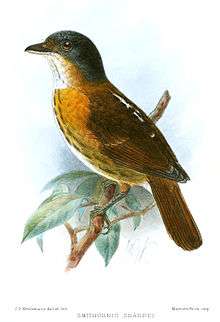Smithornis
| Smithornis | |
|---|---|
 | |
| Grey-headed broadbill (Smithornis sharpei) | |
| Scientific classification | |
| Kingdom: | Animalia |
| Phylum: | Chordata |
| Class: | Aves |
| Order: | Passeriformes |
| Family: | Eurylaimidae |
| Genus: | Smithornis Bonaparte, 1850 |
| Species | |
|
3 | |
Smithornis is a genus of birds in the family Eurylaimidae, the broadbills. The genus comprises three species native to Africa.
Before 1914 this genus was classified in the Old World flycatcher family, Muscicapidae, due to certain similarities.[1][2] Closer examination of the morphology and anatomical features of these birds resulted in their being reclassified in the Eurylaimidae.
It is hypothesized that Smithornis is a monophyletic genus, well separated from other birds in the Eurylaimidae. The differentiation occurred as a result of a division and diversification between Asian and African broadbills.[2]
Species:
- African broadbill (Smithornis capensis)
- Rufous-sided broadbill (Smithornis rufolateralis)
- Grey-headed broadbill (Smithornis sharpei)
Physiology
The species in genus Smithornis lack the vocal ability that many other birds possess. This is due to the muscular anatomy of the main vocal organ, the syrinx. The muscle A1 is widened into a hammer shape and A2 is seen to be oblique.[2] They lack a pessulus, which divides the tympaniform membranes and produces a song in other species of birds. They also lack intrinsic syringeal muscles which contract to change the song.[3]
Behavior
Smithornis are known for the rare ability to make sound with their wings. The typical behavior includes a short circular flight off of the perch and back on again, the vibration of the wings producing the sound.[4] This behavior is commonly seen in the early morning and late evening. The behavior may be related to courtship; the male produces the sound while flashing a white patch on its back when females are present.[4][5] The sound is made by all species of Smithornis; in S. capensis both sexes perform the behavior, but in S. rufolateralis only the male does so.[1]
One observation involved two individual S. capensis in which one individual flicked its wings, making the sound, while another was close by. They then alternated, taking turns performing the behavior. The behavior did not seem to be aggressive and was thought to be a courtship display.[6]
It was previously assumed that the sound was produced by the long outer 9th and 10th major covert feathers. A recent study tested the assumption by using high-speed video and audio recordings, which indicated that coverts 6 and 7 were actually producing the sound.[5]
Gallery
 Smithornis capensis capensis, 1838
Smithornis capensis capensis, 1838 Smithornis rufolateralis
Smithornis rufolateralis
References
| Wikimedia Commons has media related to Smithornis. |
- 1 2 Chapin, J. P. The Birds of the Belgian Congo: Part 3. Vol. 75A. New York: Bulletin of the American Museum of Natural History, 1953. Print.
- 1 2 3 Prum, R. O. (1993). Phylogeny, biogeography, and evolution of the broadbills (Eurylaimidae) and asities (Philepittidae) based on morphology. The Auk 110(2) 304-24.
- ↑ Greenewalt, C. H. Bird Song: Acoustics and Physiology. Washington: Smithsonian Institution, 1968. Print.
- 1 2 Bates, G. L. (1914). Some facts bearing on the affinities of Smithornis. Ibis 56(3) 495-502.
- 1 2 Clark, C. J., et al. (2016). Smithornis broadbills produce loud wing song by aeroelastic flutter of medial primary wing feathers. Journal of Experimental Biology 219(7) 1069-75.
- ↑ Lawson, W. J. (1961). Probable courtship behaviour of the broadbill Smithornis capensis. Ibis 103 289-90.